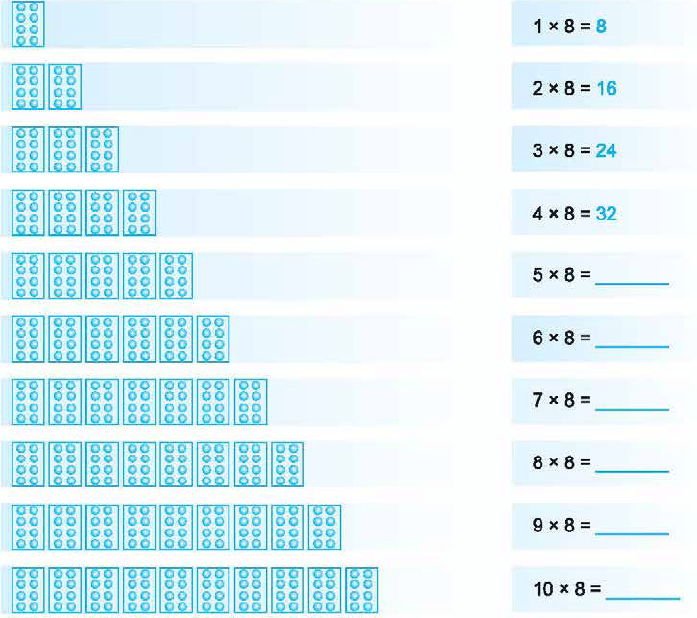Class 3 Maths - Multiplication - CBSE Worksheets
Question 1: Multiply each of the following:
Question 2: Fill in the blanks:
- 10 x ______ = 10
- 5 x 5 = ______
- 6 x 3 = ______
- ______ x 10 = 30
- ______ x 6 = 54
- ______ x 6 = 30
Question 3: Write the multiplication fact for the repeated addition:
- 8 + 8 + 8 + 8 + 8 + 8 + 8 = ______ x ______
- 5 + 5 + 5 + 5 + 5 + 5 = ______ x ______
- 3 + 3 + 3 + 3 + 3 + 3 = ______ x ______
- 8 + 8 + 8 + 8 + 8 = ______ x ______
- 4 + 4 + 4 = 3 x 4
Question 4: Let us now count the dots and get the table of 9:
Question 5: Let us now count the dots and get the table of 10:
Question 6: Complete the multiplication tables from 2 to 5:
Question 7: Let us now count the dots and get the table of 6:
Question 8: Complete the following multiplication tables:

Question 9: Let us now count the dots and get the table of 7:
Question 10: Let us now count the dots and get the table of 8:
Question 11: Fill in the blanks:
- 5 x 6 = 6 x ______
- 6 x 1 = ______
- 1 x 1 = ______
- 4 x ______ = 4
- 15 x ______ = 0
- 5 x 6 = 6 x ______
- 7 x 0 = ______
Question 12: Find the product using tables:
- 5 x 4 = ______
- 6 x 5 = ______
- 5 x 5 = ______
- 8 x 10 = ______
- 8 x 2 = ______
- 9 x 3 = ______
Question 13: Fill in the blanks:
- 10 x ______ = 10
- 6 x ______ = 54
- 4 x 9 = ______
- 6 x 5 = ______
- ______ x 3 = 21
- 4 x 8 = ______
Question 14: Using the multiplication tables, find the products:
Question 15: Multiply each of the following:
Question 16: Multiply each of the following:
Question 17: Fill in the boxes:
- 10 x 6 =

- 100 x 7 =

- 90 x 8 =

- 20 x 3 =

- 90 x 5 =

- 100 x 9 =

- 20 x 6 =

- 30 x 7 =

- 80 x 4 =

Question 18: Estimate the following sums to the nearest hundreds:
(Also, compare the estimated sums with the actual sums.)
- 375 + 236
- 273 + 504
- 173 + 58
- 287 + 189
Question 19: Estimate the following to the nearest hundreds:
(Also, compare the estimated differences with the actual differences.)
- 879 - 705
- 613 - 156
- 875 - 261
- 352 - 256
Question 20: Estimate each of the following products by rounding off each number to the nearest tens:
- 41 x 16
- 37 x 22
Question 21: A matchbox contains 50 sticks. How many sticks are there in 9 such matchboxes?
Question 22: There are 75 toffees in a box. How many toffees will there be in 5 such boxes?
Question 23: There are 30 days in a month. How many days are there in 6 months?
Question 24: A car can travel 60 km in one hour. How far will it travel in 3 hours?
Question 25: A candle factory produces 55 candles in a day. How many candles will this factory produce in 6 days?
You can access the solutions to this worksheet here.
|
12 videos|60 docs|25 tests
|
FAQs on Class 3 Maths - Multiplication - CBSE Worksheets
| 1. What is multiplication and how is it used in everyday life? |  |
| 2. How do you multiply two-digit numbers? |  |
| 3. What are some tips for improving multiplication skills? |  |
| 4. What is the difference between multiplication and addition? |  |
| 5. How can I teach multiplication to young children? |  |

|
Explore Courses for Class 3 exam
|

|
















































